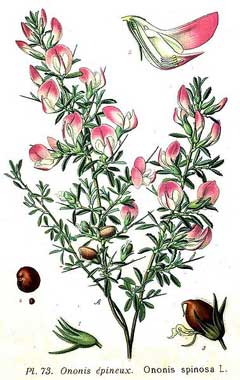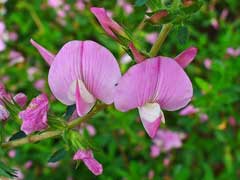 |
|
http://commons.wikimedia.org/wiki/File:73_Ononis_spinosa_L.jpg |
 |
| http://commons.wikimedia.org/wiki/User:Llez |
Translate this page:
Summary
Physical Characteristics

 Ononis spinosa is a PERENNIAL growing to 0.6 m (2ft).
Ononis spinosa is a PERENNIAL growing to 0.6 m (2ft).
See above for USDA hardiness. It is hardy to UK zone 6. It is in flower from May to August. The species is hermaphrodite (has both male and female organs) and is pollinated by Bees.
It can fix Nitrogen.
Suitable for: light (sandy), medium (loamy) and heavy (clay) soils, prefers well-drained soil and can grow in nutritionally poor soil. Suitable pH: mildly acid, neutral and basic (mildly alkaline) soils and can grow in very alkaline soils.
It cannot grow in the shade. It prefers dry or moist soil. The plant can tolerate maritime exposure.
UK Hardiness Map
US Hardiness Map
Synonyms
O. campestris. O. procurrens.
Plant Habitats
Meadow;
Edible Uses
Edible Parts: Flowers Leaves Root Shoots
Edible Uses:
Young shoots - cooked[2, 105]. Used as a potherb[183]. Roots - chewed for their liquorice-like flavour[183]. Flowers - raw. They are used as a decoration on salads[7].
References More on Edible Uses
Medicinal Uses
Plants For A Future can not take any responsibility for any adverse effects from the use of plants. Always seek advice from a professional before using a plant medicinally.
Antirheumatic Antitussive Aperient Diuretic Lithontripic
The roots, leaves and flowers are antitussive, aperient, diuretic and lithontripic[7, 9, 13, 21, 46]. The root contains a fixed oil that is anti-diuretic and an essential oil that is diuretic. If the diuretic action is required then the root should be infused and not decocted or the essential oil will be evaporated[254]. An infusion is used in the treatment of dropsy, inflammation of the bladder and kidneys, rheumatism and chronic skin disorders[9]. The roots are used occasionally, they are harvested in the autumn, cut into slices and carefully dried for later use[9]. The young shoots are more commonly used, either fresh or dried[9]. They can be harvested throughout the summer[9]. A cough mixture is made from the bark[13].
References More on Medicinal Uses
The Bookshop: Edible Plant Books
Our Latest books on Perennial Plants For Food Forests and Permaculture Gardens in paperback or digital formats.

Edible Tropical Plants
Food Forest Plants for Hotter Conditions: 250+ Plants For Tropical Food Forests & Permaculture Gardens.
More

Edible Temperate Plants
Plants for Your Food Forest: 500 Plants for Temperate Food Forests & Permaculture Gardens.
More

More Books
PFAF have eight books available in paperback and digital formats. Browse the shop for more information.
Shop Now
Other Uses
References More on Other Uses
Cultivation details
Prefers a sunny position in a well-drained neutral to alkaline soil[200]. Succeeds in poor soils, the plant often becoming spiny in such a situation[17]. Similar to O. repens but this species is not rhizomatous[200]. Mature roots are very tough and the plant gained its common name of 'Rest Harrow' because ploughs and harrows would be unable to break through it (in the days before heavy machinery was used on the land!). The whole plant is pleasantly scented when bruised[245]. This species has a symbiotic relationship with certain soil bacteria, these bacteria form nodules on the roots and fix atmospheric nitrogen. Some of this nitrogen is utilized by the growing plant but some can also be used by other plants growing nearby[200].
References Carbon Farming Information and Carbon Sequestration Information
Temperature Converter
Type a value in the Celsius field to convert the value to Fahrenheit:
Fahrenheit:
The PFAF Bookshop
Plants For A Future have a number of books available in paperback and digital form. Book titles include Edible Plants, Edible Perennials, Edible Trees,Edible Shrubs, Woodland Gardening, and Temperate Food Forest Plants. Our new book is Food Forest Plants For Hotter Conditions (Tropical and Sub-Tropical).
Shop Now
Plant Propagation
Scarify or pre-soak the seed for 24 hours in warm water and sow the seed in the middle of spring in situ[200]. The seed can also be sown in a cold frame in the autumn. When they are large enough to handle, prick the seedlings out into individual pots and plant them out in late spring[200]. Division just before new growth begins in spring[200]. Very easy, larger divisions can be planted out direct into their permanent positions. We have found that it is better to pot up the smaller divisions and grow them on in light shade in a cold frame until they are well established before planting them out in late spring or early summer. Cuttings, September in a cold frame[111].
Other Names
If available other names are mentioned here
Native Range
TEMPERATE ASIA: Afghanistan, Cyprus, Iran, Iraq, Israel, Jordan, Lebanon, Syria, Turkey, Armenia, Azerbaijan TROPICAL ASIA: India (Jammu and Kashmir), Pakistan EUROPE: Denmark, United Kingdom, Norway, Sweden, Czechoslovakia, Austria, Belgium, Switzerland, Germany, Hungary, Netherlands, Poland, Russian Federation (European part), Estonia, Lithuania, Moldova, Ukraine (incl. Krym), Former Yugoslavia, Albania, Bulgaria, Greece (incl. Crete), Italy (incl. Sardinia), Romania, Spain (incl. Baleares), France (incl. Corsica), Portugal AFRICA: Algeria (north), Libya (north), Morocco, Tunisia
Weed Potential
Right plant wrong place. We are currently updating this section.
Please note that a plant may be invasive in one area but may not in your area so it's worth checking.
Conservation Status
IUCN Red List of Threatened Plants Status :

Growth: S = slow M = medium F = fast. Soil: L = light (sandy) M = medium H = heavy (clay). pH: A = acid N = neutral B = basic (alkaline). Shade: F = full shade S = semi-shade N = no shade. Moisture: D = dry M = Moist We = wet Wa = water.
Now available:
Food Forest Plants for Mediterranean Conditions
350+ Perennial Plants For Mediterranean and Drier Food Forests and Permaculture Gardens.
[Paperback and eBook]
This is the third in Plants For A Future's series of plant guides for food forests tailored to
specific climate zones. Following volumes on temperate and tropical ecosystems, this book focuses
on species suited to Mediterranean conditions—regions with hot, dry summers and cool, wet winters,
often facing the added challenge of climate change.
Read More
Expert comment
Author
L.
Botanical References
17200
Links / References
For a list of references used on this page please go here
Readers comment
| Add a comment |
|
If you have important information about this plant that may help other users please add a comment or link below. Only comments or links that are felt to be directly relevant to a plant will be included. If you think a comment/link or information contained on this page is inaccurate or misleading we would welcome your feedback at [email protected]. If you have questions about a plant please use the Forum on this website as we do not have the resources to answer questions ourselves.
* Please note: the comments by website users are not necessarily those held by PFAF and may give misleading or inaccurate information.
To leave a comment please Register or login here All comments need to be approved so will not appear immediately.
|
|